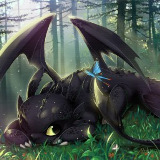Character Development: BTA (Backstory, Thoughts, Action) · 7:44am Feb 10th, 2013
Character development.
Writers run into this problem time and time again when they're creating their characters. Sometimes they feel they're "too flat". Sometimes, they're forgettable, or unlovable. Other times, they have someone with a loud and quirky behavior, and the writer NEVER GIVES AN EXPLANATION FOR IT! Here is a key tip that you have to remember.
All of your character's actions is a result of his/her backstory.
It's really that simple. Now you ask, why? I'll give you an example.
Let's say one day you're walking around in your house, and you see a stove that's turned on. Granted of the fact that you've never seen an stove before, you touch it. Ouch! The instant reaction would obviously be pain. Now, you have a backstory. You touched a stove that was turned on. Now, next time you encounter a stove that's turned on, any sane person would not touch it.
Your action, not touching the stove, is a result of your backstory, touching the hot stove.
There's also one more step in-between the action and the backstory. The thoughts. Taking the burning situation again, what would you be thinking the second time you encountered the stove? Many might think that a stove that's turned on causes pain, and pain is bad. Because of this, you do not touch the hot stove. It's a chain-reaction. The backstory influences the thoughts/mindset of the character, which then controls the character's action. When your readers know the explanation for your character's actions, they begin to relate with your character, and begin to sympathize with him/her. This is good.
From this, I've created a quick, easy, three step forumula that you can use to add more depth to your character. It consists of the following.
1. Backstory
2. Thoughts
3. Action
Now, let's take the stove situation, and apply it to the formula.
1. Backstory
- You touched a hot stove that burned your finger.
2. Thinking/Motives
- When you touch a hot stove, it hurts you.
3. Action
- You do not touch any more hot stoves.
Taking it a bit further, now that you know stoves can get hot and can hurt you, when you see another stove, you might check if it's on before touching it, or simply have a fear of stoves all together and use a microwave.
1. Backstory
- You touched a hot stove that burned your finger.
2. Thinking/Motives
- When you touch a hot stove, it hurts you.
3. Action
- You don't use any more stoves for fear that it will burn you.
Essentially, this is the basis of a three-dimensional, realistic, relatable, and lovable character. The more you reveal your character's backstory, the more you reveal about your character's thinking, and the more you explain why the character does what he does. When your reader understands why your character does what he does, you strike a familar connection with him, and thus, capture his attention. It may seem simple, but this leads up to much more complicated and complex character development.
For example, take Twilight Sparkle. We know her backstory is that she loves to read and study books.
1. Backstory
- Twilight Sparkle loves to read books.
She has been living like this presumingly for years, since she began as a young filly and grew into young adulthood. At this stage, you might need to use a little creativity to figure out. But since we're writers, we can get though it. Perhaps she believes she doesn't need friends because she never found any use for them. Her entire life was devoted to books, so why add any more? She's content with what she already has.
2. Thoughts
- Twilight Sparkle believes she doesn't need friends.
This, of course, leads to her action. She becomes anti-social, and never realizes the magic of friendship.
3. Action
- Twilight Sparkle doesn't take the time to make friends, and becomes anti-social.
If you begin with an action, you can also work backwards to create a backstory explaining why the character does a certain action. Simply flip the order.
1. Action
2. Thoughts
3. Backstory
Let's apply this to say, Fluttershy. Action: She is quiet, and rarely speaks up.
1. Action
- Fluttershy is quiet, and rarely speaks up.
Like I said before, you need some creativity to pass the second stage. It's always asking yourself why. Simply put yourself in the character's shoes, and try to understand their mindset. My explanation is that she believes her opinion is unimportant, or that she would only bother other ponies if she voices her desires.
2. Thoughts
- Her opinion isn't important, or she would simply bother other ponies.
Now, why wouldn't her opinion be important? Once again, ask why. If you need help, remember much of our behaviors originate from childhood, or very young age. The scars that cut us first always cut the deepest.
3. Backstory
- She was neglected and ignored by her parents at a young age.
And that's how you make a lovable, three-dimentional character!


